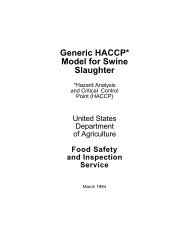Generic HACCP Model for Thermally Processed Commercial
Generic HACCP Model for Thermally Processed Commercial
Generic HACCP Model for Thermally Processed Commercial
You also want an ePaper? Increase the reach of your titles
YUMPU automatically turns print PDFs into web optimized ePapers that Google loves.
CCP Determination Form<br />
The Critical Control Point (CCP) Determination <strong>for</strong>m is used to identify the critical<br />
control points in the process. A critical control point is defined as a point, step, or procedure at<br />
which control can be applied and a food safety hazard can be prevented, eliminated, or reduced<br />
to an acceptable level. All significant hazards identified in the hazard analysis must be addressed.<br />
Identification of each CCP can be facilitated by the use of a CCP Decision Tree. The Decision<br />
Tree asks a series of four, yes or no, questions to assist in determining if a particular step is a CCP<br />
<strong>for</strong> a previously identified hazard. These four questions are listed at the top of the CCP<br />
Determination <strong>for</strong>m. Use this as a guide when determining if an identified significant hazard is<br />
a critical control point. CCP's must be carefully developed and documented and must be <strong>for</strong><br />
product safety only. Different facilities preparing the same food can differ in the risk of<br />
hazards and the points, steps, or procedures which are CCP's. This can be due to differences<br />
in each facility such as layout, equipment, selection of ingredients, or the process that is<br />
employed.<br />
In this document the CCP's that are identified are <strong>for</strong> illustrative purposes only. Your<br />
individual process will determine the CCP's identified. Remember that proper Sanitary Operating<br />
Procedures and maintenance programs are essential prerequisites to <strong>HACCP</strong>.<br />
48



